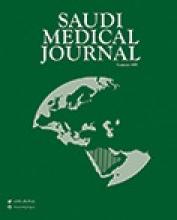Abstract
OBJECTIVE: An epidemiological study of stroke on patients admitted at King Abdul Aziz University hospital to determine the pattern of stroke, clinical presentation, risk factors and the outcome of the stroke in Saudis and non Saudis.
METHODS: Case records of patients admitted with stroke between (January 1997 to January 2000) at King Abdul Aziz University Hospital which is a teaching hospital affiliated to Ministry of Education, provides health care to multinational population of mixed socioeconomic status. The diagnosis was established by radiological assessment either by computerized tomography scan or magnetic resonance imaging. Pattern of stroke, clinical presentations, risk factors and the outcome of stroke and other relevant data were documented.
RESULTS: A total of 71 patients were admitted with stroke during the period of the study with incidence of 3% of total admission to the medical unit. The mean age was 63 years with male: female ratio of 3.4:1. Cerebral infarction was recorded in 80% of the cases. The most common presentation of stroke in Saudis were ischamic in 77% and hemorrhagic in 20.5%. Where as in non-Saudis, it was 85% and 7%. Intra cerebral hemorrhage was recorded in 15% of patients, while the subaraichnoid hemorrhage only in 1%. Ruptured aneurysm diagnosed by cerebral angiogram attributed to the cause of subarachnoid hemorrhage. Hypertension was the most important risk factor for ischamic and hemorrhagic stroke, as other risk factors were hyperlipidemia, diabetes mellitus, ischemic heart disease, atrial fibrillation and smoking. Death was the eventual outcome of stoke in 31% of patients, septicemia contributed to 35% of deaths, 77% of cerebral stokes were treated with aspirin, only 2 cases were treated by ticlopdine. Average hospital stay was 63 days, while 6 patients stayed longer than 600 days.
CONCLUSION: Stroke is a common neurological problem among patients admitted at King Abdul Aziz University Hospital and the pattern of stroke is similar to those reported from other parts of Saudi Arabia and other Arab countries. There was a high incidence of thrombotic stroke in our study. Hemorrhage was rare in our study especially subarachniod hemorrhage. Hypertension was the most common risk factor, so emphasis should be made on strict control of blood pressure in the community to reduce the incidence of stroke. Since long hospital stay was observed in our study, we recommend establishment of more nursing homes and rehabilitation centers for stoke patients aiming to decrease the burden on the teaching hospital.
- Copyright: © Saudi Medical Journal
This is an open-access article distributed under the terms of the Creative Commons Attribution-Noncommercial-Share Alike 3.0 Unported, which permits unrestricted use, distribution, and reproduction in any medium, provided the original work is properly cited.






